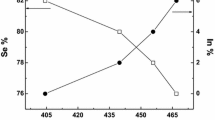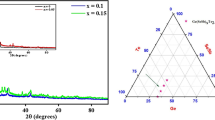Abstract
Chalcogens are elements from group VI-A of periodic table—sulfur (S), selenium (Se), and tellurium (Te). A chalcogenide glass is a glass containing one or more chalcogen element as a substantial constituent. Chalcogen (S, Se, and Te) rich glassy systems have potential applications in nonlinear optical limiting devices, IR optics, reversible optical recording, memory switching, and other applications. A quaternary glassy system (Ge20Se80)100−x(Si20Te80)x has been investigated for different important physical parameters viz. molar volume, average heat of atomization, lone pair electrons, number of constraints, average coordination number, glass transition temperature, etc. Linear variation in glass transition temperature with varying heat of atomization and variation of high refractive index as a result of increasing density may account for the optical limiting effect. The approximated critically calculated physical parameters in the present study reveal the nonlinearity and structural detail of investigated glass for various applications.
Access this chapter
Tax calculation will be finalised at checkout
Purchases are for personal use only
Similar content being viewed by others
References
Sharma A, Barman PB (2009) Calorimetric and optical study of amorphous Se85–xTe15Bix glassy alloy. Thin Solid Films 517:3020–3023
Teteris J, Reinfelde M (2003) Application of amorphous chalcogenide semiconductor thin films in optical recording technologies. J Optoelectron Adv Mater 5:1355–1360
Fu LB, Rochette M, Ta VG et al (2006) Investigation of self-phase modulation based optical regeneration in single mode As2Se3 chalcogenide glass fiber. Opt Express 13:1479–1481
Eggleton BJ, Luther-davies B, Richardson K (2011) Chalcogenide photonics. Nat Photonics 5:141–148
Wagh A, Raviprakash Y, Ajithkumar MP et al (2015) Effect of Sm2O3 on structural and thermal properties of zinc fluoroborate glasses. Trans Nonferrous Met Soc China 25:1185–1193
Riggs JE, Walker DB, Carroll DL et al (2000) Optical limiting properties of suspended and solubilized carbon nanotubes. J Phys Chem B 104:7071–7076
Troles J et al (2004) Chalcogenide glasses as solid state optical limiters at 1. 064 l m. Opt Mater 25:231–237
Nguyen HC, Yeom D, Mägi EC et al (2008) Nonlinear switching using long-period gratings in As2Se3 chalcogenide fiber. JOSA B 25:1393–1401
Siegel J, Schropp A, Solis J et al (2004) Rewritable phase-change optical recording in Ge2Sb2Te5 films induced by picosecond laser pulses. Appl Phys Lett 84:2250–2252
Sarangan A, Member S, Duran J et al (2018) Broadband reflective optical limiter using GST phase change material using GST phase change material. IEEE Photonics J 10:1–9
Petkova T, Nedeva Y, Petkov P (2001) Compositional trends of the properties in chalcogenide Ge-Se-Ga glasses. J Optoelectronics Adv Mater 3:855–860
González-Leal JM, Ledesma A, Bernal-Oliva AM et al (1999) Optical properties of thin-film ternary Ge10As15Se75 chalcogenide glasses. Mater Lett 39:232–239
Shaaban ER, Elshaikh HA, Soraya MM (2015) Compositional variation and thermal annealing effect on optical properties of Se-Te-Sb semiconductor thin films. Optoelectronics and Advanced Materials-Rapid Communications 9:587–600
Sanghera JS, Florea CM, Shaw LB et al (2008) Non-linear properties of chalcogenide glasses and fibers. J Non-Cryst Solids 354:462–467
Chandel N, Mehta N (2019) Analysis of physicochemical properties in covalent network chalcogenide glasses (ChGs): critical review of theoretical modeling of chemical bond approach. SN Appl Sci 1:657
Phillips JC, Laboratories B, Hill M (1979) Topology of covalent. J Non-Cryst Solids 34:153–181
Thorpe MF (1983) Continuous deformations in random networks. J Non-Cryst Solids 57:355–370
Phillips JC, Thorpe MF (1985) Constraint theory, vector percolation and glass formation. Solid State Commun 53:699–702
Jain N, Pancholi KC, Kakani SL (2015) Theoretical predictions on physical properties of Se-Sb-Bi glass system with compositional variations. Int J Innovative Res Sci Eng Tech 3:219–226
Fadel M (1996) The physical properties and the chemical bond approach for Se-Ge-As amorphous chalcogenide glasses. Vacuum 48:73–83
Kumar S, Singh A (2019) Study of glass-forming ability and structural chalcogenide glassy alloys, p 1594
Valency D (1963) The valence-shell electron-pair 40:295–301
Zhenhua L (1991) Chemical bond approach to the chalcogenide glass forming tendency. J Non-Cryst Solids 127:298–305
Tichg L, Ticha H (1994) On the chemical threshold in chalcogenide glasses. Mater Lett 21:313–319
Tich L, Tichfi H (1995) Covalent bond approach to the glass-transition temperature of chalcogenide glasses. J Non-Cryst Solids 189:141–146
Fayek SA, Balboul MR, Marzouk KH (2007) Optical, electrical and thermal studies on (As2Se3)3–x(As2Te3)x glasses. Thin Solid Films 515:7281–7285
Hassanien AS, Akl AA (2015) Estimation of some physical characteristics of chalcogenide bulk Cd50S50−xSex glassy systems. J Non Cryst Solids 428:112–120
Akl AA, Hassanien AS (2015) Superlattices and microstructures microstructure and crystal imperfections of nanosized CdSxSe1−x thermally evaporated thin films. Superlattices Microstruct 85:67–81
Sharma I, Sunder S (2018) Analysis of glass forming ability using percolation concept and tunability of physical parameters of a-Ge12Se76−xAs12Bix glassy semiconductors. Mater Sci-Pol 36:242–254
Sanderson RT (2016) An interpretation of bond lengths and a classification of bonds. Science 114:670–672
Fayek SA, Fouad SS (1999) Topological consideration of thallium on glassy arsenous selenide. Vacuum 52:359–363
Lankhorst MHR (2002) Modelling glass transition temperatures of chalcogenide glasses. Applied to Phase-Change Optical Recording Materials 297:210–219
Author information
Authors and Affiliations
Corresponding author
Editor information
Editors and Affiliations
Rights and permissions
Copyright information
© 2023 The Author(s), under exclusive license to Springer Nature Singapore Pte Ltd.
About this chapter
Cite this chapter
Kaushik, P., Singh, H., Devi, A. (2023). Theoretical Evaluation of (Ge20Se80)100−x(Si20Te80)x Quaternary Chalcogenide Glassy Alloy. In: Li, X., Rashidi, M.M., Lather, R.S., Raman, R. (eds) Emerging Trends in Mechanical and Industrial Engineering. Lecture Notes in Mechanical Engineering. Springer, Singapore. https://doi.org/10.1007/978-981-19-6945-4_40
Download citation
DOI: https://doi.org/10.1007/978-981-19-6945-4_40
Published:
Publisher Name: Springer, Singapore
Print ISBN: 978-981-19-6944-7
Online ISBN: 978-981-19-6945-4
eBook Packages: EngineeringEngineering (R0)




